
Francisco
was born in the state of Ceará 32 years ago and lives in
Governador Valadares, in the state of Minas Gerais. Since he was
12 years he used to explore nature and, influenced by his brother
Reginaldo, he got interested in orchids. The "cerrado"
is one of the habitats he visits more.
Report
Francisco D.V.Leitão
The
"cerrado" is a savannah kind fitogeographical domain which
occurs in many states of Brazil and in some regions of Paraguay
and Bolivia.
With an extension of 2.000.000km² approximately, it is considered
as the second biome in Brazil. Among the states which have the privilege
of counting with this biome in their territory, there are São
Paulo, Goiás, Tocantins, Bahia, Maranhão, Mato Grosso,
Mato Grosso do Sul, Piauí, Distrito Federal and, of course,
Minas Gerais.
The "cerrado" seems, at the first sight, dry, unoccupied
and suffered place, however a little walk through this prodigy of
nature is enough to fall across a divine and splendid fauna and
flora and concerning the Orchidaceae family, we multiply
the sensation of charm and admiration.
In the open "cerrado", in Carbonita neighborhood, it is
possible to find Cyrtopodium eugenii Rchb. F. &
Warm., a small plant for the genus, however with outstanding and
expressive flowers.
Most part of "cerrado" in Minas Gerais suffers with hot
and dry days with sudden fall of temperature at night. Only during
the rainy season the water is available in an expressive quantity
and it is just at the beginning of that season that many orchids
bloom. By the end of the winter, still during the critical dry period,
some species of Encyclia fill the "cerrado" with
small and varied flowers. |
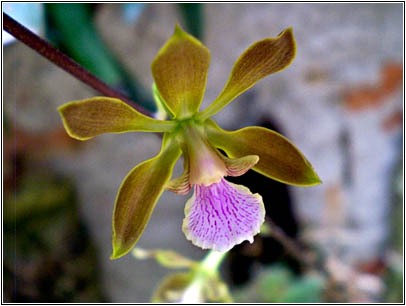
Encyclia kundergraberii V. P. Castro & Campacci |
My
friends and I noticed that in the area we visited, in Carbonita,
Encyclia kundergraberii V. P. Castro & Campacci
is one of the main epiphyte plants as well as the Encyclia patens
(Hook.) Porto & Brade. This coexistence allowed a new natural
hybrid, Encyclia xcarbonitensis Campacci, recently
described. |
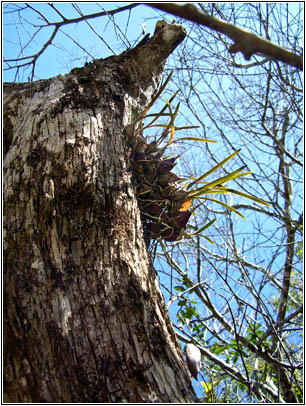
Encyclia oliveirana Campacci no habitat |
We
also found, although not very often, Encyclia oliveirana
Campacci, discovered by my brother Reginaldo de Vasconcelos Leitão
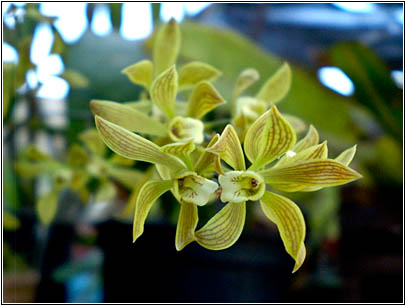
Encyclia oliveirana Campacci |
We
can also noted that the orchids with epiphyte habit, except for
the species of the genus Catasetum, always growing next to
the sources of water. Beside Encyclia, we also have the beautiful
presence of Cattleya walkeriana Gardner, Schomburgkia
sp, species of micro-orchids, such as Acianthera recurva
(Lindl.) Pridgeon & M. W. Chase, Myoxanthus lonchophyllus
(Barb. Rodr.) Luer, Notylia sp., among others. |
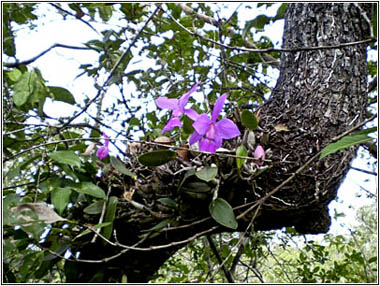 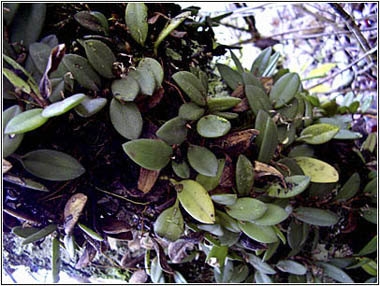 |
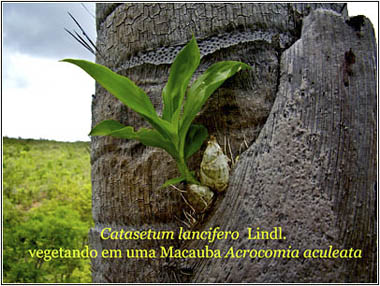 |
We just confirmed the occurrence of Catasetum lanciferum
Lindl. and Catasetum blackii Pabst growing in "macaúbas",
typical palm trees of the region, far way from the water sources,
in the middle of the dry "cerrado".
All those species which have epiphyte habit, need more environmental
humidity to survive, for that reason they should adapt themselves
to survive in the extreme conditions of the "cerrado",
which is, during the dry season, implacable and merciless.
The humidity is more preserved along the sources of water. In the
course of the years, the rains with their spates draining directly
to the rivers and creeks, opened trenches which, year by year, slowly,
became deeper. With this considerable accumulation of water, the
local vegetation develop better in the borders of those trenches,
as a result it is possible to find beautiful specimens of Aechemea
bromelifolia, a wonderful bromeliad that side by side with the
orchidaceous flora found the auspicious conditions to survive, however
just the stronger orchids such as the species of |
the genus Encyclia,
are commonly found in those trenches that accumulate water for a short
period after the rains. Many of them dry out completely while other
keep in deep wells, opening an oasis, where before was so dry as
the heart of the "cerrado". |
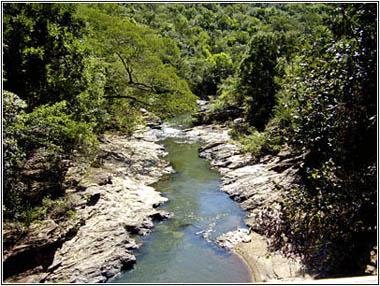 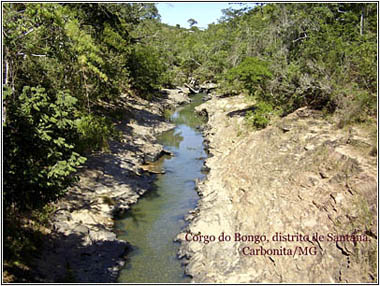 |
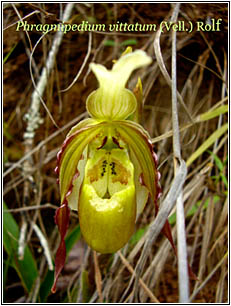 |
We had a big surprise when we came to across to a wonderful blossom
in the middle of the summer of Phragmipedium vittatum (Vell.)
Rolfe. and Bletia catenulata Ruiz & Pavon growing as
terrestrial. During the rainy season, they burst in blooming, taking
advantage of the vitality of the "errand" to show their
flowers and attract their pollinator. On the other hand, on the
river or creek bed, vegetating among the stones crevices we could
enjoyed the delicate Koellensteinia eburnea (Barb.
Rodr.) Schltr.
Phragmipedium vittatum forms big colonies on the rivers
bed. The fan shape plants are smaller when they are vegetating exposed
to the sunbeam. Those growing in the trenches, among the vegetation
protected by the shade, are bigger, reaching 60cm long and produce
more vigorous blooms. |
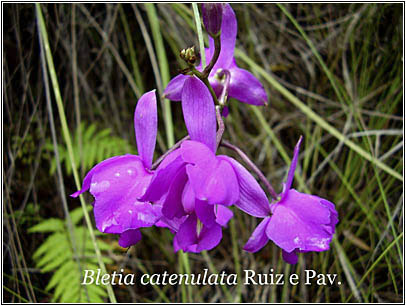
|
In face of this beauty and immensity of the "cerrado"
and its native and orchidaceous flora, it is not astonished that
the man, called the most indigent among the animals, be the responsible
for all destruction of this. It would be amazing if not tragic as
we know that "cerrado" is one of the eldest biomes of
the planet and took thousands years to reach the present form. The
man, in a while, by his greed and irrationality, goes on overthrowing
and burning this environmental patrimony for cultivating eucalyptus,
producing charcoal or anything else which only provoke damages and
irrecoverable loses.
The most incredible is that the nature, through the orchids, has
been calling on showing its beauty for all of us as asking for mercy,
begging for our attention with its forms and perfumes as a subliminal
message of it petals, sepals and lip (illegal kiln, death in the
cerrado). |
thanks to : Marli Ventura, resident of Carbonita/MG who introduced us to the city
and the region.
Adjarme de Oliveira and Jefferson de Faria, my companions in the expeditions.
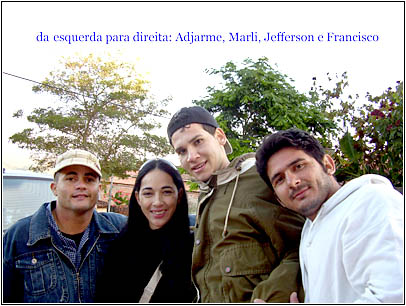
(from the left to the right: Adjarme, Marli, Jefferson and Francisco)
Obs.: The legends inside the photos are made by the author
Any
kind of reproduction (print, digital or anyone) of any type of material
of this site: texts, layout, photos, images and others - is
strictly forbidden without previous written permission of the authors.
Any solicitation or information by the e-mail: bo@sergioaraujo.com |
|